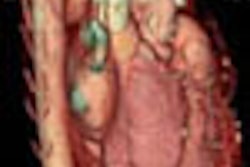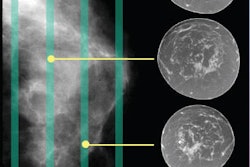It doesn't guarantee reimbursement, but coronary CT angiography (CCTA) will have its own specific CPT codes as of January 1, 2006. Physicians should use other codes only in limited instances, experts say, and they'll also need to make sure they're reading the noncoronary areas on the images.
The American Medical Association (AMA), which holds the copyright on the Current Procedural Terminology (CPT) and determines the codes, recently announced the new CCTA codes so that payors would have time to prepare for their implementation.
The new codes are Category III codes, used for gathering data on emerging procedures. As such, they don't carry any relative value units (RVUs) for determining reimbursement.
But the new codes will presumably result in less confusion than the unlisted procedure code, 76497, which the AMA advises using now and through December 31.
What isn't clear as yet is whether coding will change in those regions where local Medicare Part B carriers have adopted Local Coverage Determinations (LCDs) that pay for CCTA under the chest CTA code, 71275.
These local Medicare carriers include Group Health Incorporated in New York, Empire in New York, Empire in New Jersey, HGSA in Pennsylvania, and Palmetto GBA in South Carolina.
Dr. David Dowe of Atlantic Medical Imaging in Galloway, NJ, who has been sharing his insight on building a private CCTA practice with AuntMinnie.com, is fortunate to work in an area where Medicare pays for the service, even if it is just a $675 global payment.
His local Medicare carriers currently authorize coding CCTA under the chest CTA code. Without knowing what those carriers may require after January 1, Dowe is a little leery about the upcoming Category III codes.
"There's danger in using just the data-gathering codes," Dowe said. "You could basically find yourself with no reimbursement for things that you used to get reimbursed for. And when you're carrying the note on a $1.7 million CT scanner, that's no joke."
The American College of Radiology's top coding advisor cautions that practitioners who use other codes in the absence of specific guidance from a payor may be taking a risk.
"If a code exists, one is required to use the code that accurately describes that service. There's no wiggle room as there used to be in the past," said Dr. Richard Duszak, a radiologist in Reading, PA, and chairman of the ACR committee on coding and nomenclature.
"If a physician were to use inaccurate codes when they were not advised to do so specifically by a carrier, and were doing it to get paid for services that were otherwise not payable, I would be concerned that it would fall under the federal False Claims Act," Duszak said.
Also, Duszak noted, "providers need to recognize that if one payor has chosen to ignore the CPT guidance, that doesn't mean that's correct coding for other payors."
Duszak also defended the joint decision by the ACR and the American College of Cardiology (ACC) to seek Category III codes for CCTA rather than Category I codes that might carry a greater likelihood of reimbursement.
"The AMA CPT panel has very specific, defined, rigorous criteria that are necessary to meet a Category I code," Duszak said. "Our hope is that with increased peer-reviewed research and the data-tracking the Category III codes will afford, we will have positioned ourselves to move forward with the Category I application when these codes have met that burden."
The ACR and ACC also agreed in their application for the new Category III CCTA codes that the interpretation of the axial 2D source images would be a required component, he said.
"Any provider -- whether radiologist or cardiologist -- who is billing for the various cardiac CT codes, and particularly coronary CTA, is responsible for the interpretation of whatever pathology may be present on the axial source images," Duszak noted.
So would that requirement give either specialty an advantage in the turf tussle over CCTA? "I'm sure there was no intent whatsoever to disenfranchise any specialty provider who has been appropriately trained," Duszak replied.
The following lists the new CCTA codes as of January 1, 2006:
- 0146T CT angiography of coronary arteries (including native and anomalous coronary arteries, coronary bypass grafts), without quantitative evaluation of coronary calcium
- 0147T CCTA with quantitative evaluation of coronary calcium
- 0148T Cardiac structure and morphology and CCTA, without quantitative evaluation of coronary calcium
- 0149T Cardiac structure and morphology and CCTA, with quantitative evaluation of coronary calcium
Four additional Category III cardiac CT codes will go into effect January 1:
- 0144T CT, heart, without contrast material, including image postprocessing and quantitative evaluation of coronary calcium
- 0145T CT, heart, without contrast material followed by contrast material(s) and further sections, including cardiac gating and 3D image postprocessing; cardiac structure and morphology
- 0150T Cardiac structure and morphology in congenital heart disease
- 0151T CT, heart, without contrast material followed by contrast material(s) and further sections, including cardiac gating and 3D image postprocessing; function evaluation (left and right ventricular function, ejection fraction, and segmental wall motion)
By Tracie L. Thompson
AuntMinnie.com staff writer
July 26, 2005
Related Reading
ACR sets standards for noninvasive cardiac imaging, June 6, 2005
Midwest weighs incremental Medicare gain for VC, May 26, 2005
CMS provides details on new PET coverage, April 8, 2005
Cardiac CT societies merge, as field's golden age dawns, March 9, 2005
Medicare to expand carotid artery stenting coverage, December 20, 2004
Copyright © 2005 AuntMinnie.com




















